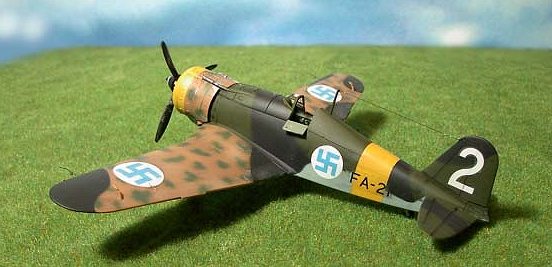
Pacific Coast Models 1/48 Fiat G.50bis/AS
|
KIT # |
48001 |
|
PRICE: |
$38.95 |
|
DECALS: |
See review |
|
REVIEWER: |
Denis Moisan |
|
NOTES: |
Multi-media kit with resin and photo etch parts. |

|
HISTORY |
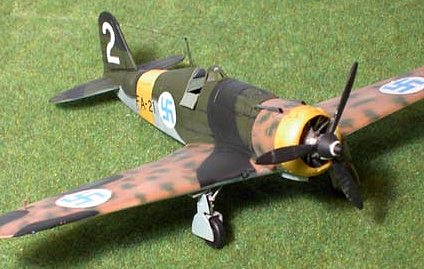 The first all-metal single-seat monoplane fighter to enter
service in the Italian Air Force, the Fiat G-50 was the second Fiat design to
carry the name Freccia ‘Arrow’, the Fiat CR.32 biplane being also named Freccia.
The enclosed cockpit fitted to the early production models was not liked by the
pilots as it was said to badly hamper vision and was also very difficult to
open in an emergency. So it was quickly replaced by an open cockpit. In early
1939 twelve G-50 were sent to Spain but as the civil war was coming to an end
they didn’t saw any combat.
The first all-metal single-seat monoplane fighter to enter
service in the Italian Air Force, the Fiat G-50 was the second Fiat design to
carry the name Freccia ‘Arrow’, the Fiat CR.32 biplane being also named Freccia.
The enclosed cockpit fitted to the early production models was not liked by the
pilots as it was said to badly hamper vision and was also very difficult to
open in an emergency. So it was quickly replaced by an open cockpit. In early
1939 twelve G-50 were sent to Spain but as the civil war was coming to an end
they didn’t saw any combat.
In October 1940, the Fiat G-50 of 20 Gruppo started operating from Belgium to take part in raids against England but, once again (and surely for the better), without encountering any enemey fighters. They were recalled to Italy on January 1941. The Freccia was also used in operations against Greece. The Finnish Air Force used the G-50 during the continuation war against Russia in 1941. In spite of its light armament and open cockpit without any heating the Finns were able to shot down an impressive number of enemy aircraft. Even if the G-50 was nearing obsolescence at the start of the war, it soldiered on to the end of the war on a variety of fronts.
|
THE KIT |
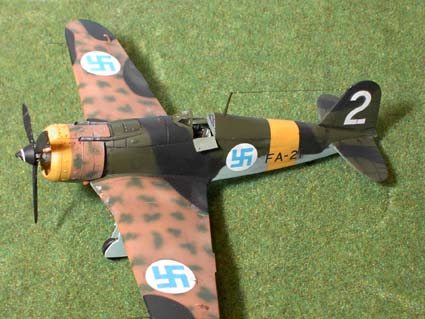 This is the old Secter kit
reissued by Pacific Coast Models with a lot of resin and photo etch goodies
thrown in. You also get a new decal sheet from Skymodels in addition to the
original one by Secter, this gives you more than 20 versions to choose from.
Here is a link to a preview.
This is the old Secter kit
reissued by Pacific Coast Models with a lot of resin and photo etch goodies
thrown in. You also get a new decal sheet from Skymodels in addition to the
original one by Secter, this gives you more than 20 versions to choose from.
Here is a link to a preview.
|
CONSTRUCTION |
Ok, since it is a multimedia kit, you must study the instructions carefully. There are three instruction sheets here : one for the original kit, one for the photo- etched parts and one for the resin parts. Let’s start with the cockpit, the resin parts are really nice and are a real improvement from the original cockpit. The only fit problem encountered here was with the doors (parts 10-11) you will have to trim them a bit if you want them to fit. The photo-etched parts for the cockpit are from Eduard and are quite nice, but, due to the use of the resin parts in the cockpit they are not very useful.
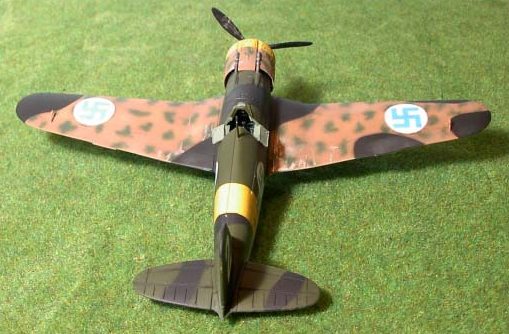 Apart from the instrument
panel and film, only a few where actually used. The fact that there is no
photo-etched seat belts is a big disappointment. The cockpit was painted
Aeromaster RAF Interior Green lighted with a bit of white. The instrument panel
and control boxes where painted black. Next came the fuselage, a bit of dry
fitting and sanding will give you a good fit. The wings go together well, again
dry fitting and sanding is a must. The engine provided with the kit is not that
good so I ordered a resin replacement from Engines and Things. The resin cowling
is a gem, care must be taken while removing it from its casting block, mine
broke and I was able to save it only after a lot of work, cursing and sanding. I
did not use the resin propeller and spinner but they look great.
Apart from the instrument
panel and film, only a few where actually used. The fact that there is no
photo-etched seat belts is a big disappointment. The cockpit was painted
Aeromaster RAF Interior Green lighted with a bit of white. The instrument panel
and control boxes where painted black. Next came the fuselage, a bit of dry
fitting and sanding will give you a good fit. The wings go together well, again
dry fitting and sanding is a must. The engine provided with the kit is not that
good so I ordered a resin replacement from Engines and Things. The resin cowling
is a gem, care must be taken while removing it from its casting block, mine
broke and I was able to save it only after a lot of work, cursing and sanding. I
did not use the resin propeller and spinner but they look great.
|
PAINT & DECALS |
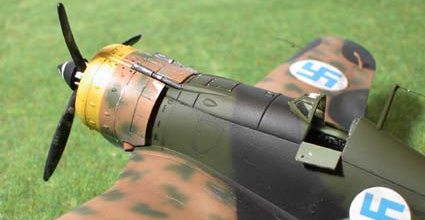 As I am a
big fan of Finnish Air Force’s aircrafts, I used Aeromaster’s 48-144C sheet. One
of the planes on that sheet is finished in a combination of Finnish and Italian
camouflage. I couldn’t resist, so even with over twenty markings offered I had
to use aftermarket decals. Aeromaster’s Italian Sand, Flat Black, Field green
and RLM 65 enamel was used.
As I am a
big fan of Finnish Air Force’s aircrafts, I used Aeromaster’s 48-144C sheet. One
of the planes on that sheet is finished in a combination of Finnish and Italian
camouflage. I couldn’t resist, so even with over twenty markings offered I had
to use aftermarket decals. Aeromaster’s Italian Sand, Flat Black, Field green
and RLM 65 enamel was used.
|
CONCLUSIONS |
This is not a kit for the beginner, but the average modeller will be able to get a good looking model with a bit of work.
December 2002
If you would like your product reviewed fairly and fairly quickly, please contact the editor or see other details in the Note to Contributors.